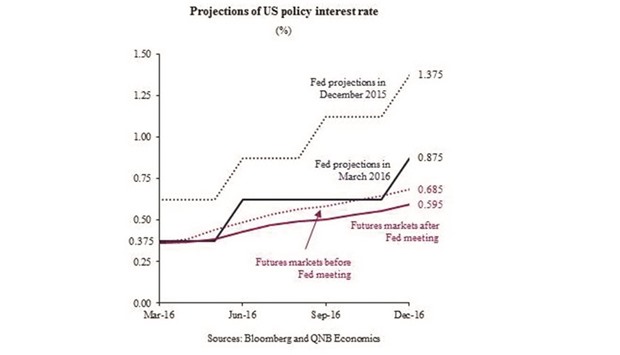The Fed has given markets “a dovish surprise” on March 16 when it revised down its projections for the policy rate in 2016 from four hikes to two hikes of 25 basis points each, QNB has said.
QNB said the move was a bigger downward revision than expected and led to lower market interest rates in the US and a weaker dollar, which has provided a reprieve to central banks around the world, freeing up space for easier monetary policy.
“However, there are a number of reasons to believe that markets may have overreacted to the Fed’s dovish messages and a more hawkish surprise could be in store down the road,” QNB said.
After its March meeting, QNB said the Fed kept its main interest rate target unchanged at 0.25%-0.5%, as expected. “However, it lowered its projections for policy rates at the end of 2016 from 1.375% in December to 0.875% currently.
It is possible to decipher four main reasons for this downward revision,” according to QNB.
First, the Fed stated that global economic and financial developments pose risks to the economic outlook. The bank noted that the start of 2016 “has been plagued by severe volatility in global financial markets.
This has prompted the Fed to become more cautious about raising rates.”
Second, weak US economic data early in the year has led to a small downward revision to the Fed’s real GDP projections.
The Fed now expects the economy to expand by 2.2% in 2016 compared with a forecast of 2.4% in December.
Third, the Fed has revised down its estimate of the long-run unemployment rate from 4.9% in December to 4.8%. This, according to QNB, is the rate at which the Fed considers the economy to be at full employment. With unemployment currently at 4.9%, QNB said lowering the estimate of long-run unemployment reduces the pressure on the Fed to raise interest rates to cool the economy.
Finally, the Fed has revised down its projections for headline inflation at the end of the year from 1.6% in December to 1.2%, as a result of lower oil prices.
“This is well below the Fed’s target of 2%. The Fed’s key inflation measure is core inflation (excluding food and energy), which has not been revised down. However, the Fed may be taking the lower headline inflation numbers into account,” the bank said.
According to QNB, lower US interest rates could be beneficial for the world economy by easing monetary policy at a time when other major central banks may be running out of options to spur growth.
The policy interest rates of the two other major global central banks, the Bank of Japan and the European Central Bank, are sinking deeper into negative territory and their quantitative easing programmes are losing efficacy, it said.
In emerging markets, QNB said lower US interest rates and a weaker dollar provide more room for central banks to cut rates without instigating capital flight and weaker exchange rates. A number of emerging market central banks has already lowered rates since the Fed’s meeting, such as Bank Indonesia and, reportedly, the People’s Bank of China, according to QNB.
“However, the stimulus from easier monetary policy by a dovish Fed may not last. There are a number of reasons to believe that there are upside risks to the Fed’s central projection of two hikes this year,” QNB said.
First, the global economy appears to be getting back on track after a rough start to the year and global financial markets have recovered. Second, the jobs market in the US remains strong and the economy could soon rise above full employment, increasing the likelihood that the Fed would raise interest rates.
Third, the Fed’s projection of two hikes is based on the median of forecasts generated by the participants in Fed meetings. However, a significant proportion of participants still expect more than two hikes.
Out of 17 participants, nine project two hikes this year, seven project more than two hikes and only one projects a single hike. This suggests that it would not take a significant improvement in US economic data to tip the Fed back towards a higher number of rate increases.
Finally, the Fed’s forecasts for inflation could be too low. Core inflation unexpectedly rose to 1.7% in January from 1.5% in December, rapidly approaching the Fed’s 2% target. The Fed expects this measure of inflation to ease during 2016 and is forecasting 1.6%, in line with its projection in December 2015.
However, markets and a number of commentators expect core inflation to remain persistently higher.
“Therefore, the market response to the dovish Fed may be overdone and markets could have set themselves up for a hawkish surprise down the line. As long as there are no more shocks to economic growth and global financial markets, more than two Fed rate hikes could still be on the cards this year, which could lead to a stronger dollar and tighter monetary policy in emerging markets,” QNB said.

MARKET


